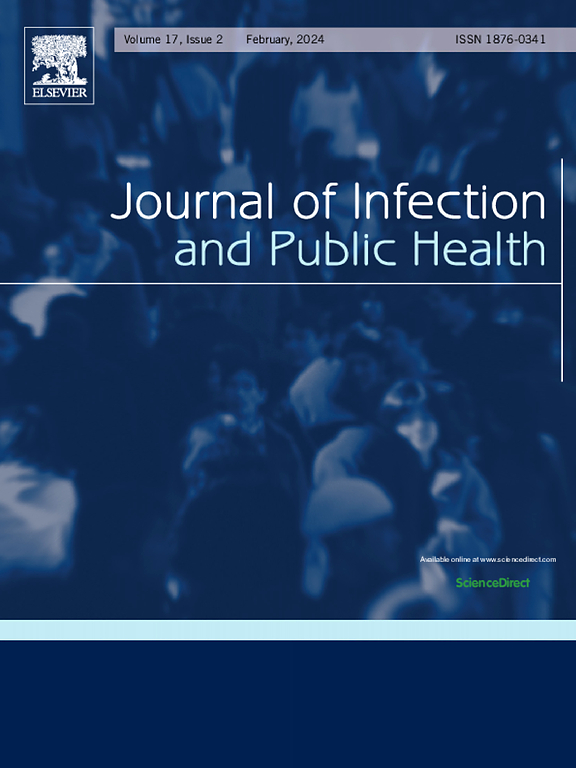Genetic diversity and antimicrobial resistance of clinical Klebsiella pneumoniae isolates: An ISSR-PCR analysis
IF 4
3区 医学
Q1 INFECTIOUS DISEASES
引用次数: 0
Abstract
Background
Klebsiella pneumoniae is a major nosocomial pathogen associated with severe infections and increasing antimicrobial resistance. The study aimed to investigate the genetic diversity of K. pneumoniae clinical isolates using Inter Simple Sequence Repeat (ISSR) primers to assess strain differentiation and evolutionary relationships.
Methods
A total of 144 K. pneumoniae isolates were obtained from clinical samples in a tertiary care hospital. Standard microbiological and biochemical techniques were used for bacterial identification. Antibiotic susceptibility testing was performed using the Kirby-Bauer disk diffusion method. Genomic DNA was extracted, and ISSR-PCR was conducted using 19 primers to analyze genetic diversity. Banding patterns were scored, and genetic relationships were determined using Jaccard's coefficient and the Unweighted Pair Group Method with Arithmetic Mean (UPGMA) to construct a phylogenetic dendrogram. Principal Component Analysis (PCA) was also applied to assess variability among isolates.
Results
The antibiotic resistance profile revealed a high prevalence of multidrug-resistant (MDR) K. pneumoniae, with resistance to beta-lactams, aminoglycosides, and fluoroquinolones. ISSR-PCR analysis exhibited significant genetic polymorphism, with ISSR 1, ISSR 7, and ISSR 15 generating the highest number of bands. The resolving power of ISSR 11 and ISSR 14 was the highest (0.889 and 0.867), indicating their efficacy in distinguishing closely related strains. Phylogenetic analysis clustered the isolates into two major groups, suggesting genetic heterogeneity. PCA further confirmed genetic variability, with distinct clusters forming among isolates.
Conclusion
The study underscores the genetic diversity of K. pneumoniae isolates and the utility of ISSR markers in bacterial typing. The high prevalence of MDR strains highlights the urgent need for enhanced molecular surveillance and infection control strategies. ISSR-PCR offers a cost-effective alternative for epidemiological studies, though integration with whole-genome sequencing could provide deeper insights into resistance mechanisms.
临床肺炎克雷伯菌分离株的遗传多样性和耐药性:ISSR-PCR分析
背景肺炎克雷伯菌是一种主要的院内病原体,与严重感染和日益增加的抗菌素耐药性有关。本研究旨在利用ISSR引物研究肺炎克雷伯菌临床分离株的遗传多样性,以评估菌株分化和进化关系。方法共144张 K。从一家三级保健医院的临床样本中分离出肺炎菌。采用标准微生物学和生化技术进行细菌鉴定。采用Kirby-Bauer纸片扩散法进行药敏试验。提取基因组DNA,利用19条引物进行ISSR-PCR分析遗传多样性。利用Jaccard's系数和UPGMA (Unweighted Pair Group with Arithmetic Mean)确定遗传关系,构建系统发育树状图。主成分分析(PCA)也用于评估菌株间的变异。结果多药耐药(MDR)肺炎克雷伯菌高发,对-内酰胺类、氨基糖苷类和氟喹诺酮类耐药。ISSR- pcr分析显示出显著的遗传多态性,ISSR 1、ISSR 7和ISSR 15产生的条带数量最多。ISSR 11和ISSR 14的分辨能力最高(分别为0.889和0.867),说明其对近缘菌株的分辨能力较强。系统发育分析将分离物分为两大类群,表明遗传异质性。PCA进一步证实了遗传变异,在不同的分离株之间形成不同的簇。结论该研究强调了肺炎克雷伯菌分离株的遗传多样性和ISSR标记在细菌分型中的应用。耐多药菌株的高流行率突出了加强分子监测和感染控制战略的迫切需要。ISSR-PCR为流行病学研究提供了一种具有成本效益的替代方法,尽管与全基因组测序相结合可以更深入地了解耐药性机制。
本文章由计算机程序翻译,如有差异,请以英文原文为准。
求助全文
约1分钟内获得全文
求助全文
来源期刊

Journal of Infection and Public Health
PUBLIC, ENVIRONMENTAL & OCCUPATIONAL HEALTH -INFECTIOUS DISEASES
CiteScore
13.10
自引率
1.50%
发文量
203
审稿时长
96 days
期刊介绍:
The Journal of Infection and Public Health, first official journal of the Saudi Arabian Ministry of National Guard Health Affairs, King Saud Bin Abdulaziz University for Health Sciences and the Saudi Association for Public Health, aims to be the foremost scientific, peer-reviewed journal encompassing infection prevention and control, microbiology, infectious diseases, public health and the application of healthcare epidemiology to the evaluation of health outcomes. The point of view of the journal is that infection and public health are closely intertwined and that advances in one area will have positive consequences on the other.
The journal will be useful to all health professionals who are partners in the management of patients with communicable diseases, keeping them up to date. The journal is proud to have an international and diverse editorial board that will assist and facilitate the publication of articles that reflect a global view on infection control and public health, as well as emphasizing our focus on supporting the needs of public health practitioners.
It is our aim to improve healthcare by reducing risk of infection and related adverse outcomes by critical review, selection, and dissemination of new and relevant information in the field of infection control, public health and infectious diseases in all healthcare settings and the community.
 求助内容:
求助内容: 应助结果提醒方式:
应助结果提醒方式:


